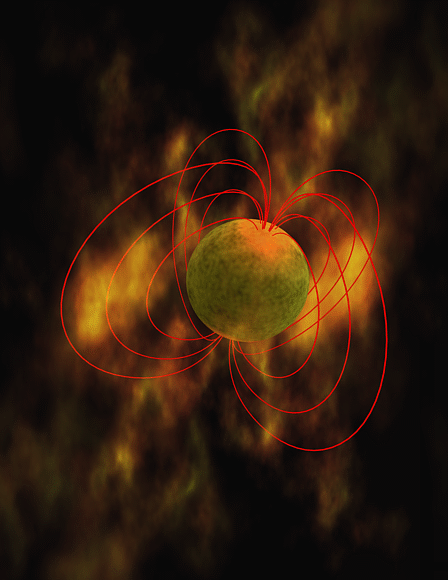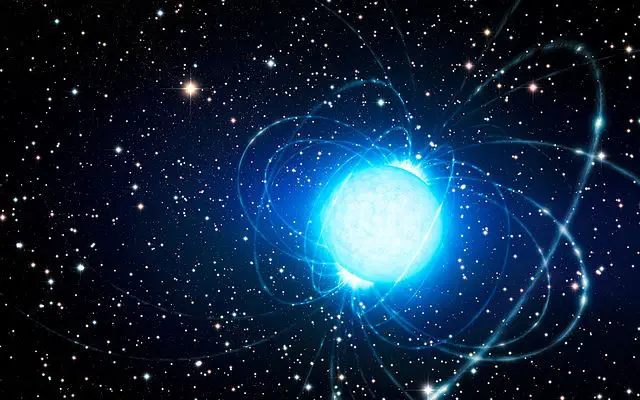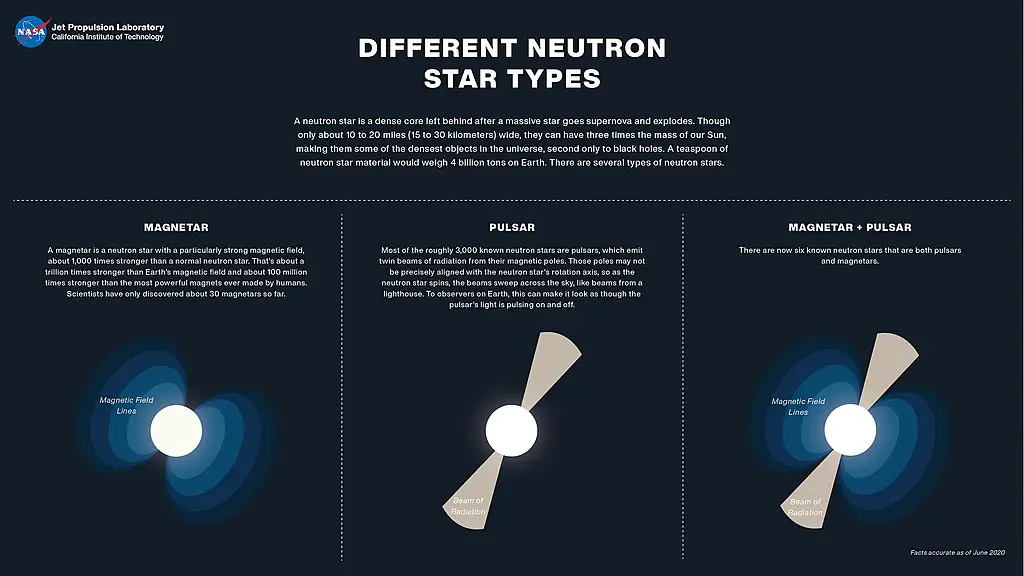Have you ever heard about magnetars? Most likely not, but these objects are some of the most powerful and mysterious cosmic phenomena in the known universe. Magnetars, also known as soft gamma repeaters, are neutron stars with incredibly powerful magnetic fields.
They produce intense radiation and high-energy particles which makes them extremely interesting to astrophysicists. In this article, we’ll take a closer look at magnetars, their characteristics, detection, and their importance in astrophysics.
Introduction
A neutron star is the result of a supernova explosion, the death of a massive star. It is a very dense remnant from the star’s core, with a mass of 1.4 to 3 times that of the sun, but occupying a volume no larger than a small city. These neutron stars have incredibly strong magnetic fields which are millions of times stronger than the Earth’s magnetic field.
When the magnetic field of a neutron star is even stronger than usual, it is called a magnetar. These objects are believed to have magnetic fields up to 1,000 times stronger than a normal neutron star. The intense magnetic fields of magnetars cause them to rotate rapidly and generate intense radiation and high-energy particles.

Magnetars also have an incredibly hot surface temperature of around 1 million degrees Celsius, which is much hotter than the surface temperatures of other types of neutron stars. They also emit X-rays and gamma rays, making them easier to observe from Earth.
In addition to their intense magnetic fields, magnetars also have incredibly rapid spins. They can spin once every few seconds, making them the fastest-rotating objects in the universe. This rapid rotation is thought to be the cause of the magnetar’s intense radiation and high energy particles.
Although magnetars are very rare, they are some of the most energetic objects in the universe. Since most of their energy is emitted in the form of gamma rays, their radiation can be seen from hundreds of light years away. As such, magnetars provide an excellent opportunity to study the most extreme conditions in the universe.
In the rest of this article, we’ll explore the formation of magnetars, their detection, and their importance in astrophysics. We’ll also take a look at some of the important characteristics of magnetars, such as their magnetic field strength, spin down, and X-ray spectra. Finally, we’ll explore their activity, and the importance of magnetar research in astrophysics. So, let’s get started!
How Do We Detect Magnetars?
Magnetars are some of the most mysterious and powerful objects in the universe, and as such, they have been the subject of much research and study. But how do we actually detect these cosmic powerhouses? Astronomers have developed a number of techniques to detect magnetars, allowing us to learn more about their characteristics and importance in astrophysics.
The most common way to observe magnetars is to detect their X-ray and gamma-ray emissions. X-rays are the most powerful form of electromagnetic radiation, and they are emitted by magnetars due to their intense magnetic fields. This radiation is detectable by the X-ray satellites in orbit around the Earth. Gamma-rays are even higher energy than X-rays, and they are also emitted by magnetars. Gamma-rays are detectable by both space-based and ground-based detectors.
In addition to these powerful emissions, optical emissions can also be detected from magnetars. Optical emissions are less energetic than X-rays or gamma-rays, but they can still be detected from magnetars due to their intense magnetic fields. Optical emissions can be detected by ground-based telescopes.
Once the emissions from magnetars have been detected, astronomers can then use a variety of methods to identify the objects as magnetars. For example, astronomers can measure the pulsations of the X-ray or gamma-ray signals, which can be used to identify the object as a neutron star. Other methods include measuring the spin down of the magnetar or the X-ray spectra.
Data from all of these observations can then be used to learn more about the characteristics of individual magnetars. This data can be used to measure the magnetic field strength, spin down rate, and X-ray spectra of the objects, which all provide crucial information about the nature of the magnetar.
In addition, data from observations can also be used to measure the activity of magnetars. In particular, X-ray bursts, radioactivity, and soft gamma repeater activity can all be used to measure the level of activity of a magnetar. All of this data is necessary for understanding the importance of magnetars in astrophysics.
Magnetars in Astrophysics
Magnetars have captivated astronomers since their discovery in 1979. These enigmatic objects are believed to be a subclass of neutron stars that possess a magnetic field of an incredible strength up to 10^15 gauss, approximately a thousand trillion times stronger than the Earth’s magnetic field.
Thanks to this immense force, magnetars are responsible for a huge variety of high-energy phenomena, and have a significant role in furthering our understanding of astrophysics.
The most obvious way in which magnetars differ from other stars is the sheer strength of their magnetic field. In addition to this, they are believed to be spinning significantly faster than other neutron stars (up to several hundred times per second). This high spin rate leads to an outflow of energy from the star in the form of X-ray and gamma-ray emissions, as well as soft gamma repeater activity.
Magnetars are also believed to be responsible for a significant fraction of the cosmic radiation detected in space. This radiation is composed of highly energetic particles, such as protons and electrons, that are thought to originate from the star’s powerful magnetic field.

This radiation can be detected with instruments such as X-ray detectors, gamma-ray detectors, and optical telescopes, allowing astronomers to study the behavior of magnetars.
In addition to being a source of cosmic radiation, magnetars also play an important role in understanding the nature of neutron stars. By studying the behavior of magnetars, astronomers can gain insight into how these stars evolve over time and the effects of extreme magnetic fields on their structure. This knowledge helps us to further our understanding of the entire universe.
Magnetars are also able to generate powerful X-ray bursts, as well as radioactivity and soft gamma repeater activity. These phenomena are believed to be a result of the star’s highly energetic magnetic field. The burst activity is capable of releasing more energy in a few seconds than our Sun does in one million years, providing astronomers with a unique opportunity to study the behavior of neutron stars.
The study of magnetars is incredibly important in astrophysics, as they provide us with valuable insight into the evolution of neutron stars. By studying how these stars behave under extreme conditions, astronomers can gain a better understanding of the entire universe. Magnetars are also responsible for a significant fraction of the cosmic radiation detected in space, making them a valuable source of high energy particles. Finally, magnetars generate powerful X-ray bursts and other phenomena, giving astronomers a unique opportunity to study the behavior of neutron stars.
Important Characteristics of Magnetars
Magnetars are some of the most extreme objects found in space. They are a class of neutron stars that are characterized by their extreme magnetic fields. These magnetic fields are up to a thousand trillion times stronger than the average magnetic field of Earth, making them truly unique. Below, we explore some of the most important characteristics of magnetars and how they differ from other neutron stars.
Magnetic Field Strength
The defining feature of magnetars is their incredibly strong magnetic fields. The magnetic field strength of magnetars can reach up to 10^14 Gauss, which is up to a thousand trillion times more intense than the Earth’s magnetic field. It is estimated that the magnetic energy density around a magnetar is almost a billion times greater than the energy density of the interstellar medium.
These incredibly strong magnetic fields are created by a process known as dynamo, where ions and electrons in the star’s core generate electric currents. This produces an intense magnetic field which extends outward from the star, beyond its atmosphere.
Spin Down
Magnetars also have incredibly strong spin-down luminosities. This is due to the fact that magnetars have very short spin periods, which means they rotate very quickly. In fact, some magnetars have been known to spin as fast as a few hundred times per second. This rapid rotation helps to power the star’s magnetic field.
The spin-down luminosity of a magnetar is determined by its magnetic field strength. The stronger the magnetic field, the higher the spin-down luminosity. This is why magnetars are brighter than other neutron stars.
X-ray Spectra
The X-ray spectra of magnetars is also very different from that of other neutron stars. X-ray spectra is used to study the internal structure of a magnetar. It is also used to measure the temperature of the star’s atmosphere.
The X-ray spectra of a magnetar is characterized by a “hard tail” component. This hard tail is caused by the high energy particles emitted by the magnetar. These particles can reach energies of up to a few hundred keV, much higher than the energy of photons emitted by other neutron stars.
These hard X-ray photons can also be used to probe the magnetic field and spin-down of a magnetar. This helps scientists better understand the properties of these unique stars.
The X-ray spectra of magnetars also reveals information about the star’s magnetic field structure. This helps scientists to better understand the process of magnetar formation.
Magnetars are truly unique cosmic objects. Their defining characteristics, such as their incredibly strong magnetic fields, high spin-down luminosities, and hard X-ray spectra, make them unlike any other objects found in space. By studying these characteristics of magnetars, we can better understand the nature of these powerful stars and their role in astrophysics.
Magnetar Activity
Magnetars are incredibly energetic and active objects in space, releasing powerful bursts of energy across the electromagnetic spectrum. One of the most fascinating aspects of magnetars is their ability to produce strong bursts of X-rays, gamma rays, and other emissions.
These bursts can be both short and long in duration, and are usually associated with changes in the magnetic field of the magnetar.
X-Ray Bursts:
One of the most commonly observed forms of activity is the release of short, intense bursts of X-rays. These X-ray bursts last anywhere from a fraction of a second to tens of seconds and have been observed to peak at around 10$^{37}$ erg/s.
The origin of X-ray bursts is still not fully understood, though they are thought to be related to changes in the magnetic field of the magnetar.
Radioactivity:
Radioactivity is another type of activity observed in magnetars. This phenomenon is caused by the decay of unstable nuclei within the magnetar’s intense magnetic field. As these nuclei decay, they release gamma rays, which can then be detected from Earth.
Soft Gamma Repeater Activity:
In addition to X-ray bursts and radioactivity, magnetars are also capable of producing occasional bursts of gamma rays. These bursts, known as soft gamma repeaters (SGRs), are thought to be caused by changes in the magnetic field of the magnetar. The duration of these bursts can range from a few milliseconds to several days, and they tend to peak at gamma-ray energies of around 10$^{33}$ erg/s.
Studying the activity of magnetars is an important part of understanding their nature and importance in astrophysics. The different types of activity observed from magnetars can provide valuable insight into the structure and evolution of neutron stars.
Additionally, the intense energetic output of magnetars can be used to study the behavior of high energy particles in the universe.
The Importance of Magnetars
Magnetars are of immense importance to astrophysics due to their extreme properties and capabilities. Their study can shed light on a wide range of cosmic phenomena. They serve as both a source of curiosity and a tool for exploration.
One of the most important features of magnetars is their unusually high magnetic field strength. As a result, they are capable of emitting intense bursts of X-ray radiation. These X-ray bursts, which are produced by the rapid release of the magnetars’ energy, can last anywhere from a few milliseconds to several hours. They can be detected from Earth, making them a valuable source of information for astrophysicists.
Another key characteristic of magnetars is their spin down. As they age, they gradually decrease their spin rate. This spin-down process releases energy in the form of radio waves, gamma rays, and X-rays. This energy can tell us a great deal about the properties of the magnetar and its environment.
The X-ray spectra of magnetars can also tell us a great deal about their properties. By studying the different spectral lines that are emitted, astrophysicists can gain valuable insight into the composition of the magnetar’s surface. This information can help us understand the evolution of neutron stars.

In addition to their X-ray and gamma-ray emission, magnetars are also capable of generating radioactivity. They can be detected through the observation of radio pulses, which can provide valuable insight into the magnetar’s activity. Additionally, magnetars are capable of producing powerful bursts of gamma radiation known as soft gamma repeaters. These bursts can tell us a great deal about the magnetar’s age and composition.
The study of magnetars has also been of great use in understanding the evolution of neutron stars. By understanding the properties of magnetars, astrophysicists can gain a better understanding of the life cycle of a neutron star. Additionally, magnetars can serve as a source of high-energy particles, which can be used to study the structure of the interstellar medium.
Finally, magnetars are an important source of high-energy radiation. By studying this radiation, astrophysicists can gain a better understanding of how the universe works. This radiation can also be used to probe the nature of dark matter and dark energy, as well as the structure of the universe itself.
In summary, magnetars are of immense importance to astrophysics. They are capable of producing intense X-ray bursts, radioactivity, and soft gamma repeaters. By studying their properties, we can gain valuable insight into the evolution of neutron stars and the structure of the interstellar medium. Additionally, magnetars are an important source of high-energy radiation, which can be used to probe the nature of dark matter and dark energy.
Conclusion
The study of magnetars has been an important stepping stone in understanding the nature of neutron stars. Magnetars have a variety of properties that make them unique from other cosmic bodies, including their exceptionally high magnetic field strength and spin down. Observations of magnetars have allowed us to better identify them, usually through their X-ray, gamma-ray, and optical emission. In addition, magnetar research has revealed a great deal about the origins of neutron stars, their evolution, and their potential role in cosmic radiation.
The importance of magnetar research in astrophysics is twofold. On the one hand, magnetars have provided physicists with a greater understanding of the nature of neutron stars. This understanding is immensely important in furthering our knowledge of the universe and its evolution. On the other hand, magnetars are also known to be sources of high-energy radiation, which can be used to probe distant astronomical objects and even provide clues to the origins of life.
When it comes to magnetar activity, X-ray bursts, radioactivity, and soft gamma repeater activity have all been observed. X-ray bursts are brief yet intense outbursts of X-ray emission, while radioactivity is the emission of radio waves from magnetars. Finally, soft gamma repeater activity is an occurrence when magnetars emit short and intense bursts of gamma rays at regular intervals.
The significance of studying magnetars is immense. Our understanding of neutron stars has been greatly enhanced by the research conducted on magnetars. In addition to helping to elucidate the evolution of neutron stars, magnetars have also been found to be a source of high-energy radiation. This radiation can be used to probe distant astronomical objects and even provide clues to the origins of life. Furthermore, the study of magnetars has also been integral in advancing our understanding of the universe and its evolution.
In conclusion, magnetars are some of the most mysterious and powerful objects in the universe. By studying them, we have been able to gain a greater insight into the nature of neutron stars, their evolution, and their potential role in cosmic radiation. Magnetars have also been found to be sources of high-energy radiation, which can be used to probe distant astronomical objects and even provide clues to the origins of life. The study of magnetars is essential to advancing our knowledge of the universe, and the future of magnetar research is sure to be an exciting one.
